A comparison of the anti-inflammatory and anti-nociceptive activity of nitroaspirin and aspirin
- PMID: 10694241
- PMCID: PMC1571848
- DOI: 10.1038/sj.bjp.0703064
A comparison of the anti-inflammatory and anti-nociceptive activity of nitroaspirin and aspirin
Abstract
1. Nitroaspirin (2.5 - 50 mg kg(-1), i.p. or 2.5 - 100 mg kg(-1), p.o.) and aspirin (2.5 - 100 mg kg(-1), i.p. or p.o.) exhibit anti-inflammatory activity in the carrageenan-induced hindpaw oedema model in the rat. When administered i.p., nitroaspirin was a more effective anti-oedema agent than aspirin particularly in the 'early' phase (i.e. up to 60 min) of the response. The ED(50) values for nitroaspirin and aspirin as inhibitors of the 'late' phase response (measured at 180 min) were 64.3 micromol kg(-1) and >555 micromol kg(-1), respectively. When administered p.o., neither nitroaspirin nor aspirin exhibited significant anti-inflammatory activity in the 'early' phase and were of similar potency in the 'late' phase. Thus, at the highest dose used (100 mg kg(-1), 360 min) orally administered nitroaspirin (aspirin in parenthesis) inhibited oedema formation by 46.9+/-1.6% (47.2+/-3.8%, both n=6, P<0.05). 2. Nitroaspirin and aspirin (25 - 200 mg kg(-1), p.o.) caused dose-related inhibition of the hyperalgesia to mechanical stimulation following intraplantar injection of carrageenan in the rat. ED(50) values were 365 micromol kg(-1) and 784 micromol kg(-1), respectively. Neither drug influenced the threshold for mechanical stimulation in the contralateral (i.e. untreated) hindpaw. 3. Nitroaspirin and aspirin (2.5 - 100 mg kg(-1), p.o.) caused dose-related inhibition of acetic acid induced abdominal constrictions in the mouse (ED(50) values of 154.7 micromol kg(-1) and 242.8 micromol kg(-1), respectively). 4. Nitroaspirin and aspirin (>200 mg kg(-1), p.o.) reduced the 'late' phase (but not the 'early' phase) of the formalin-induced hindpaw licking assay in the mouse. Similarly, nitroaspirin and aspirin (>50 mg kg(-1), p.o.) prolonged tail withdrawal latency following application of a noxious heat stimulus in the mouse.
Figures
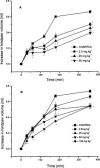

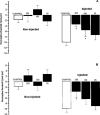
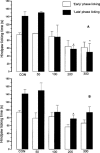
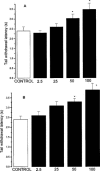

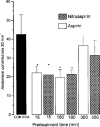
References
-
- AL-SWAYEH O.A., CLIFFORD R.H., MOORE P.K. Nitroaspirin – a novel anti-inflammatory and anti-hyperalgesic agent. Mediat. Inflamm. 1999;8:S95.
-
- CALHOUN W., GILMAN S.C., DATKO L.J., COPENHAVER T.W., CARLSON R.P. Interaction studies of tilomisole, aspirin and naproxen in acute and chronic inflammation with assessment of gastrointestinal irritancy in the rat. Agents Actions. 1992;36:99–106. - PubMed
-
- CUZZOLIN L., ADAMI A., DEGAN M., CRIVELLENTE F., BONAPACE S., MINUZ P., BENONI G. Effect of single and repeated doses of a new nitroderivative of acetylsalicylic acid on platelet TxA2 production in rats. Life Sci. 1996;58:207–208. - PubMed
-
- D'AMOUR F.E., SMITH D.L. A method for determining loss of pain sensation. J. Pharm. Exp. Ther. 1941;72:74–79.
-
- DAVIES N.M., ROSETH A.G., APPLEYARD C.B., MCKNIGHT W., DEL SOLDATO P., CALIGNANO A., CIRINO G., WALLACE J.L. NO-naproxen vs naproxen: ulcerogenic, analgesic and anti-inflammatory effects. Aliment. Pharmacol. Ther. 1997;11:69–79. - PubMed
Publication types
MeSH terms
Substances
LinkOut - more resources
Full Text Sources
Other Literature Sources
Medical

